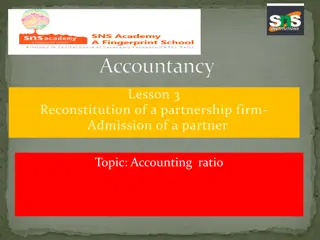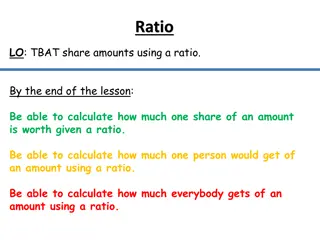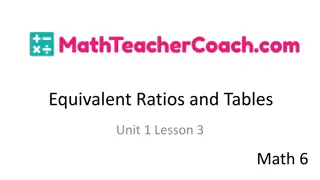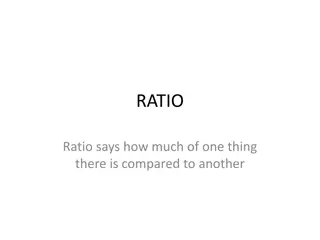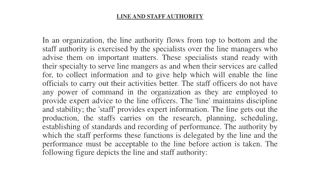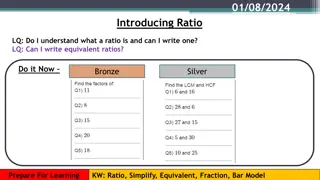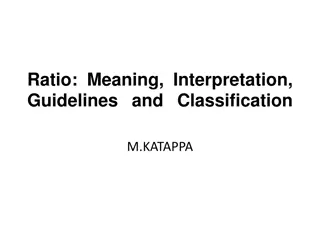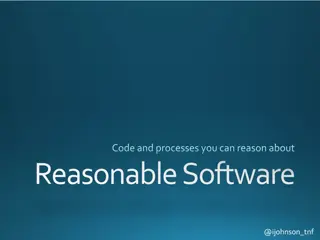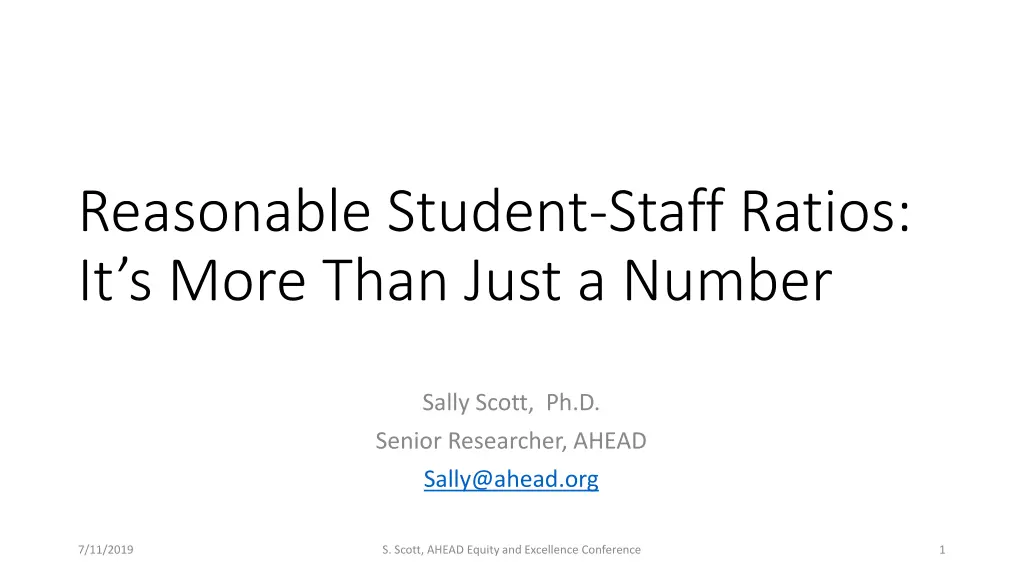
Exploring Reasonable Student-Staff Ratios and Case Loads in Disability Resource Offices
Understanding reasonable student-staff ratios and case loads in disability resource offices is more than just numbers. This article delves into national data, guiding questions, complexities, benchmarks, and research findings to help professionals in the field make informed decisions. Considerations span from individual student case loads to program-level ratios, reflecting the diverse nature of disability resource offices. Explore how different office structures, staff numbers, and student populations influence this vital aspect of student support in higher education.
Download Presentation

Please find below an Image/Link to download the presentation.
The content on the website is provided AS IS for your information and personal use only. It may not be sold, licensed, or shared on other websites without obtaining consent from the author. If you encounter any issues during the download, it is possible that the publisher has removed the file from their server.
You are allowed to download the files provided on this website for personal or commercial use, subject to the condition that they are used lawfully. All files are the property of their respective owners.
The content on the website is provided AS IS for your information and personal use only. It may not be sold, licensed, or shared on other websites without obtaining consent from the author.
E N D
Presentation Transcript
Reasonable Student-Staff Ratios: It s More Than Just a Number Sally Scott, Ph.D. Senior Researcher, AHEAD Sally@ahead.org 7/11/2019 S. Scott, AHEAD Equity and Excellence Conference 1
Guiding Questions What do national data tell us about average student numbers for case load in disability resource offices? How does this compare to your own work load with students? Beyond the numbers: What do we need to consider to determine a reasonable case load? 2 7/11/2019 S. SCOTT, AHEAD EQUITY AND EXCELLENCE CONFERENCE
Why is the question of case load complicated for disability resource offices? Our offices are so different! Different numbers of staff Different office structures Different and changing student populations Different campus missions But we can learn from having some benchmarks and national averages to compare. 3 7/11/2019 S. SCOTT, AHEAD EQUITY AND EXCELLENCE CONFERENCE
AHEADs Research The Biennial Surveys of the membership 2016 focused on DS Professionals (included individual student case loads) 2018 focused on DS Programs (included student-staff ratios) All reports are on the AHEAD website https://www.ahead.org/research/information-services-portal Free member benefit or may be purchased 4 7/11/2019 S. SCOTT, AHEAD EQUITY AND EXCELLENCE CONFERENCE
How many students with disabilities do you work with on an individual basis? 30% 25% 23% 25% Percent of respondents 20% 15% 15% 11% 10% 7% 6% 4% 3% 5% 2% 1% 1% 1% 0% 0% Number of students 7/11/2019 S. Scott, AHEAD Equity and Excellence Conference 5
Average number of students on professional case load by size of institution 280 300 Number of Students 250 213 206 190 190 200 157 150 120 85 100 50 0 Size of Institution 6 7/11/2019 S. SCOTT, AHEAD EQUITY AND EXCELLENCE CONFERENCE
Average number of students on professional case load by type of institution 190 190 200 164 180 Number of Students 160 136 140 120 100 80 80 60 40 20 0 Research university A post Comprehensive university Baccalaurate Two-year college baccalaureate professional school Type of Institution 7 7/11/2019 S. SCOTT, AHEAD EQUITY AND EXCELLENCE CONFERENCE
How can you use this data? On your own Jot down two ways you can use these research findings on national averages Turn to a partner and talk in pairs Share your ideas for using this research With the group Share and discuss 7/11/2019 S. Scott, AHEAD Equity and Excellence Conference 8
Possible uses for this data Annual report Funding request Program evaluation Other? **See the AHEAD Information Services portal case studies related to using data** 7/11/2019 S. Scott, AHEAD Equity and Excellence Conference 9
These are averages, but what makes a case load reasonable or not? Some other data to consider on your own campus 10 7/11/2019 S. SCOTT, AHEAD EQUITY AND EXCELLENCE CONFERENCE
What percentage of your work for disability What percentage of your work for disability resources/services is devoted to DIRECT provision of resources/services is devoted to DIRECT provision of individual contact and support for students? individual contact and support for students? 32% 32% 35% 28% Percent of responses 30% 26% 26% 24% 25% 17% 17% 20% 15% 10% 5% 0% 0-25% 26-50% 51-75% 76-100% Time Allocation JOB DESCRIPTION ACTUAL 11 7/11/2019 S. SCOTT, AHEAD EQUITY AND EXCELLENCE CONFERENCE
How often do you meet with students each semester/term? 48% Percent of respondents 21% 12% 10% 3% 2% 2% 2% 0% 0% 0 1,2 3,4 5,6 7,8 9,10 11,12 13,14 15,16 more than 16 Number of meetings 12 7/11/2019 S. SCOTT, AHEAD EQUITY AND EXCELLENCE CONFERENCE
What is the average length of time of an individual student meeting? The most common amount of time allocated for student meetings are 30 minutes ( 32%) 60 minutes (26%) 45 minutes (18%) 13 7/11/2019 S. SCOTT, AHEAD EQUITY AND EXCELLENCE CONFERENCE
What is the average wait time for a student What is the average wait time for a student who requests an appointment? who requests an appointment? 100% 86% 90% 80% 70% 63% 60% 50% 40% 33% 30% 20% 14% 10% 4% 0.20% 0% 0% 0% Less than 1 week 1-2 weeks 3-4 weeks More than 4 weeks Wait time Beginning of the academic year Throughout the academic year 14 7/11/2019 S. SCOTT, AHEAD EQUITY AND EXCELLENCE CONFERENCE
In an emergency or urgent situation, what is In an emergency or urgent situation, what is the average wait time for an appointment? the average wait time for an appointment? More than 4 days 1% 1-2 days 23% 3 4 days 1% Same day 75% 15 7/11/2019 S. SCOTT, AHEAD EQUITY AND EXCELLENCE CONFERENCE
Perceptions of our work with individual students How would you rate the following areas related to your individual student work? 1= Strongly Disagree 2 3 4 5= Strongly Agree 16 7/11/2019 S. SCOTT, AHEAD EQUITY AND EXCELLENCE CONFERENCE
What is an *ideal* number of students for individual student work? ? 35% 30% 30% 25% 19% 18% 20% 17% 15% 10% 7% 7% 5% 1% 0% 0-50 51-100 101-150 151-200 201-250 251-300 >300 Number of students 17 7/11/2019 S. SCOTT, AHEAD EQUITY AND EXCELLENCE CONFERENCE
Wrap Up Questions or Comments? What else do you need to know to examine reasonable load on your campus? - data from your own office/campus? - data from AHEAD? 18 7/11/2019 S. SCOTT, AHEAD EQUITY AND EXCELLENCE CONFERENCE
Thank you! Citation for this data: Scott, S. (2017). Disability Resource Professionals and Their Individual Work with Students. Huntersville, NC: Association on Higher Education and Disability. 2017 and 2018 Reports are Available at: https://www.ahead.org/professional- resources/information-services- portal/benchmark-data (free for members; fee- based for non-members) Questions? Feel free to e-mail Sally@ahead.org 19 7/11/2019 S. SCOTT, AHEAD EQUITY AND EXCELLENCE CONFERENCE

